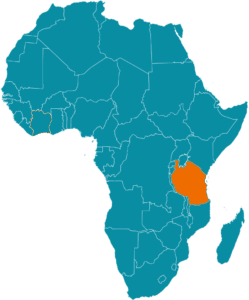our field
 The Land
The Land
Tanzania is found in East Africa, and the country shares its borders with Kenya, Uganda, Malawi, Mozambique, Zambia, DRC, Burundi, Comoro islands, and Rwanda. The country also has a coastline along the Indian Ocean. The name Tanzania is a compound word which was created after the two states of Tanganyika and Zanzibar were combined to create one country, and the name was also changed to Tanzania.
Tanzania comprises many lakes, national parks, and Africa’s highest point, Mount Kilimanjaro (5,895 m or 19,341 ft). Northeast Tanzania is mountainous, while the central area is part of a large plateau covered in grasslands. The country also contains the southern portion of Lake Victoria on its northern border with Uganda and Kenya.
The People
Tanzania has the largest population in East Africa and the lowest population density; more than a third of the population is urban. Tanzania’s youthful population – over 60% of the population is under 25 as of 2020 – is growing rapidly because of the high total fertility rate of 4.4 children per woman, as of 2022. Progress in reducing the birth rate has stalled, sustaining the country’s nearly 3% annual growth rate. The maternal mortality rate has improved since 2000, yet it remains very high because of early and frequent pregnancies, inadequate maternal health services, and a lack of skilled birth attendants – problems that are worse among poor and rural women. Tanzania has made strides in reducing under-5 and infant mortality rates, but a recent drop in immunization threatens to undermine gains in child health. Malaria is a leading killer of children under 5, while HIV is the main source of adult mortality.
For Tanzania, most migration is internal, rural to urban movement, while some temporary labor migration from towns to plantations takes place seasonally for harvests. Tanzania was Africa’s largest refugee-hosting country for decades, hosting hundreds of thousands of refugees from the Great Lakes region, primarily Burundi, over the last fifty years. However, the assisted repatriation and naturalization of tens of thousands of Burundian refugees between 2002 and 2014 dramatically reduced the refugee population. Tanzania is increasingly a transit country for illegal migrants from the Horn of Africa and the Great Lakes region who are heading to southern Africa for security reasons and/or economic opportunities. Some of these migrants choose to settle in Tanzania.
The Missions Work
Tanzania has a population of more than 53 million people, which represent more than 120 different ethnic, linguistic or religious people groups. Followers of Islam make up 30% of the population, and 51% identify as Christian. While Christianity is widespread, so is syncretism with animistic ethnic religions. Some say that Christianity in Tanzania is a mile wide but only an inch deep. There is great need for discipleship and strengthening of churches.
Tanzania’s location on Africa’s eastern coast places it in the path of the spread of Islam, which has left many northern and eastern countries closed to missions work, yet Tanzania remains open to sharing the gospel with Muslims and others. Sharing sound, biblical teaching and planting new churches are critical efforts in strengthening the foundation of faith in Tanzania.
for team bolivia
